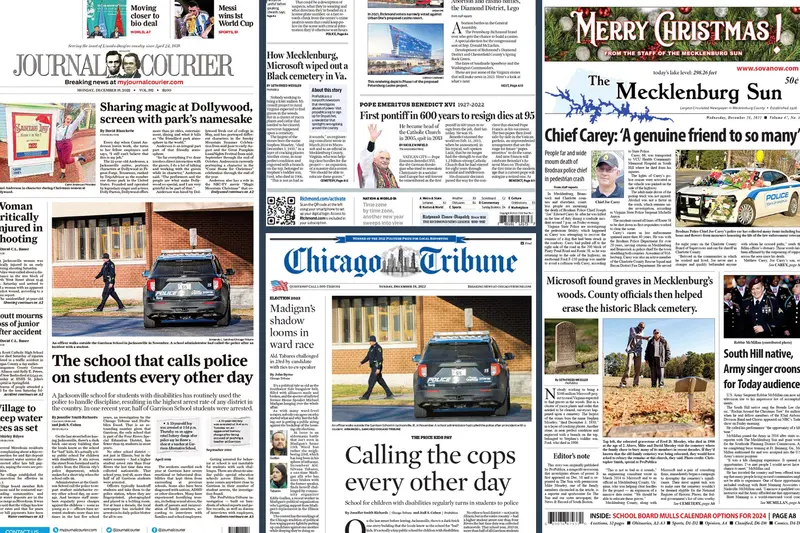10 Easy Facts About News Articles Explained
10 Easy Facts About News Articles Explained
Blog Article
The 45-Second Trick For News Articles
Table of ContentsThe 8-Second Trick For News ArticlesGetting My News Articles To WorkAll about News ArticlesNews Articles Fundamentals ExplainedNews Articles for Dummies
Great expertise of different subjects gives trainees an affordable edge over their peers. Even though electronic and social media sites are easily accessible, we must not forget just how important it is to review the newspapers. Parents must try and instill the habit of checking out a paper as an everyday regimen to continue the tradition of the adored print medium.News stories also include at the very least one of the adhering to important characteristics family member to the desired audience: distance, prominence, timeliness, human interest, oddity, or repercussion.
Within these restrictions, news tales additionally intend to be detailed. Amongst the larger and more revered papers, justness and equilibrium is a major factor in providing info.
Papers with an international audience, for example, have a tendency to use a much more official design of composing. News Articles.; usual design overviews consist of the and the United States Information Style Publication.
The 45-Second Trick For News Articles
As a guideline, reporters will not use a lengthy word when a brief one will certainly do. Information writers try to stay clear of utilizing the same word much more than once in a paragraph (in some cases called an "resemble" or "word mirror").
Headlines sometimes omit the topic (e.g., "Jumps From Boat, Catches in Wheel") or verb (e.g., "Feline lady lucky"). A subhead (also subhed, sub-headline, subheading, caption, deck or dek) can be either a secondary title under the major heading, or the heading of a subsection of the short article. It is a heading that comes before the primary message, or a team of paragraphs of the main text.
of an article topic, source, or interviewee), it is described as a drawn quote or pull quote. Additional billboards of any of these types might appear later in the post (particularly on subsequent web pages) to entice more analysis. Journalistic sites in some cases make use of computer animation techniques to swap one billboard for an additional (e.g.
7 Simple Techniques For News Articles
Such signboards are likewise used as reminders to the short article in other sections of the publication or website, or as promotions for the item in various other publication or sites. News release of the Swiss federal government. Typical structure with title, lead paragraph (recap in strong), various other paragraphs (information) and contact details.

Instance of a hard-lead paragraph NASA is suggesting another area job. The agency's budget demand, announced today, included a plan to send out another mission to the Moon. This time the firm intends to develop a long-term center as a jumping-off factor for various other area adventures. The budget plan requests approximately $10 billion for the job.
An "off-lead" is the 2nd most vital front page news of the day. To "hide the lead" is to start the write-up with history information or details of additional significance to the viewers, requiring them to review even more deeply right into a write-up than they should have to in order to uncover the click over here necessary factors.
A Biased View of News Articles
Typical use is that one or 2 sentences each develop their very own official site paragraph. Reporters typically explain the organization or structure of an information tale as an upside down pyramid. The necessary and most intriguing elements of a tale are put at the beginning, with supporting info adhering to in order of decreasing relevance.
It allows people to discover a topic to just the depth that their inquisitiveness takes them, and without the imposition of details or subtleties that they could take into consideration irrelevant, but still making that information offered to a lot more interested readers. The inverted pyramid structure additionally makes it possible for posts to be trimmed to any kind of arbitrary length during format, to suit the area available.
Some authors begin their tales with the "1-2-3 lead", yet there are several kinds of lead available. This style usually starts with a "Five Ws" opening up paragraph (as explained over), followed by an indirect quote that offers to sustain a significant aspect of the first paragraph, and then a direct quote to support the indirect quote. [] A twist can refer to several things: The last tale current program; a "delighted" story to end the program.
Longer short articles, such as magazine cover short articles and the pieces that lead the within sections of a paper, are understood as. Function stories vary from straight news in several means.
See This Report on News Articles
The journalist often details interactions with over at this website interview topics, making the piece more individual. A feature's initial paragraphs frequently associate a fascinating moment or event, as in an "anecdotal lead". From the details of a person or episode, its sight rapidly widens to abstract principles regarding the tale's topic. The area that indicates what an attribute is around is called the or billboard.

The Editor's Tool kit: A Reference Overview for Beginners and Professionals (2001) Allan M. Siegal and William G. Connolly. The New York City Times Manual of Style and Usage: The Authorities Design Overview Used by the Writers and Editors of the Globe's Many Authoritative Paper (2002) M. L. Stein, Susan Paterno, and R.
Report this page